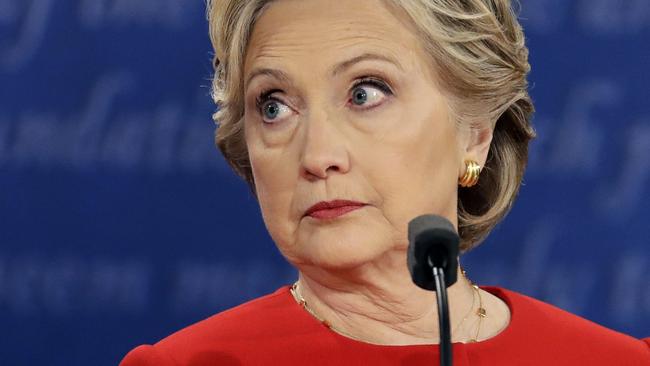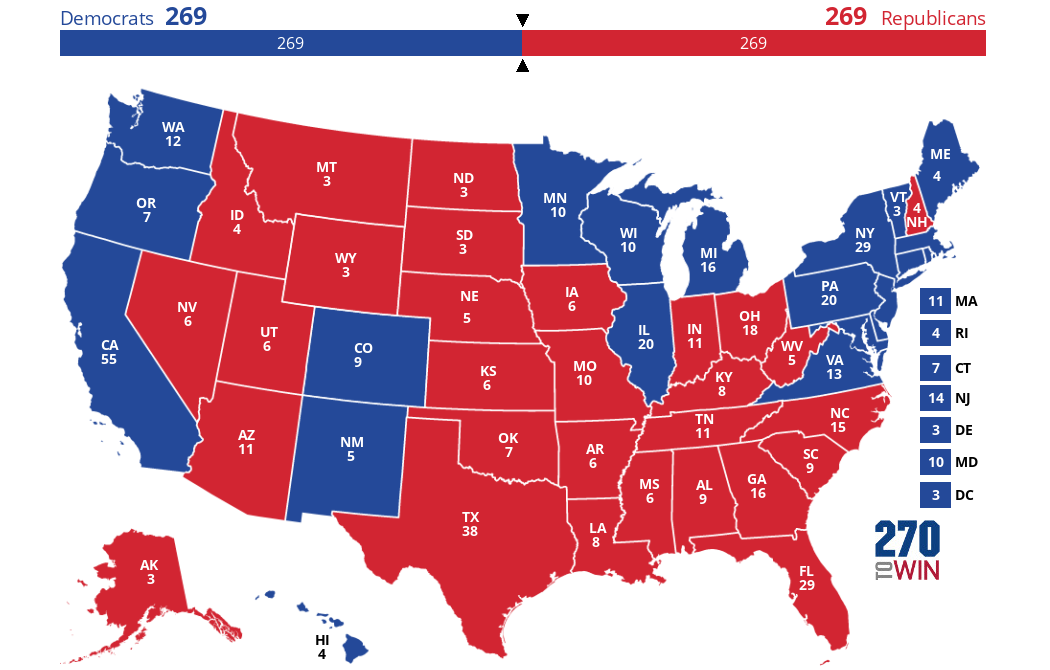The Electoral College explained: How a president is elected
THE key to victory for Donald Trump and Hillary Clinton lies in something called the “Electoral College”.
AMERICA’S electoral system is confusing to say the least.
Contrary to what you might expect, the president is not elected by a simple majority of the popular vote. That would be too easy. Instead, the key to victory for Donald Trump and Hillary Clinton lies in something called the “Electoral College”.
Here’s how it works.
THE RACE TO 270
Technically, when more than 100 million Americans go to the polls on November 8, none of them will be voting directly for a presidential candidate. Their votes are actually used to choose a group of “electors”, who then pick the next president on their behalf.
You’ve probably seen this map once or twice before. It shows all 50 American states, along with the number of electoral votes up for grabs in each. These electoral votes — one for each elector — are the key to the election.

There are 538 of them in total, divided between the states according to their population. For example California, a large state, has 55 electoral votes, while sparsely-populated Idaho has just four.
On election day, whoever wins the popular vote in any given state claims all of that state’s electoral votes — and the first candidate to 270 electoral votes is declared president-elect. That’s the finish line.
The map above shows what happened four years ago, when President Obama beat Mitt Romney. The states Mr Obama won are coloured blue, while Mr Romney’s states are red. Mr Obama got 51 per cent of the popular vote compared to Mr Romney’s 47 per cent, which sounds close, but the electoral vote was a far more convincing 332-206.
Why? Because Mr Obama won a bunch of key swing states, such as Florida, Ohio and Virginia, by narrow margins. If just a fraction of the 125 million total votes cast had gone the other way in those key states, the landslide would have been a nailbiter instead.
The point here is that the national popular vote doesn’t matter. It’s all about winning the right combination of states to reach that magic number, 270.

SOME STATES MATTER MORE THAN OTHERS
The thing is, most states always vote the same way. Utah, for instance, hasn’t voted for a Democrat since 1964, and New York hasn’t gone Republican since 1988. So the result of the election hinges on the small handful of swing states that are genuinely up for grabs.
According to the polls, the only states within reach for both Donald Trump and Hillary Clinton are Florida, North Carolina, Virginia, Pennsylvania, Ohio, Michigan, Wisconsin, Iowa, Colorado, Arizona, New Hampshire and Nevada. On election day, those are the states to watch.
WHAT HAPPENS NEXT?
On the second Wednesday after the election, the 538 electors we mentioned earlier will cast their own votes to officially choose the president.
Why are there 538? It is a weirdly specific number, but with logic behind it. There’s one elector for each member of Congress — 435 representatives plus 100 senators — and another three representing Washington D.C.
The electors are usually Republican or Democratic officials selected by the major parties. Most of them are not technically bound to vote for the candidate who won their state, but delegates very rarely go rogue.
This time, however, there could be a problem. One Democratic elector, from the state of Washington, has told the media he will never vote for Hillary Clinton.
“No, no, no on Hillary. Absolutely not. No way,” Robert Satiacum told the Seattle Times. “I hope it comes down to a swing vote and it’s me. Good. She ain’t getting it. Maybe it’ll wake this country up.”
If Ms Clinton wins or loses the election by a comfortable margin, it won’t matter. But say she finishes with exactly 270 electoral votes — Mr Satiacum’s stubbornness could cost her the presidency.

THE NIGHTMARE SCENARIO
There are two longshot scenarios that would stop both candidates from reaching 270 electoral votes. First, it is possible for Mr Trump and Ms Clinton to win a specific combination of states and tie with 269 votes apiece. Second, independent candidate Evan McMullin could pull off a surprise victory in the usually Republican state Utah, thereby depriving Mr Trump of a majority.
Mr McMullin, a conservative, only joined the presidential race in August because he was disillusioned with Mr Trump’s extreme rhetoric.
“We’re not trying to win 270 votes,” he has admitted. “What we’re trying to do is earn enough electoral votes to block Hillary Clinton and Donald Trump, if the race between both of them is so close that we are able to do that by winning one or two states.”
Say Mr McMullin’s strategy succeeds, or Ms Clinton and Mr Trump tie. In that case, the election will be sent to the House of Representatives, where each state delegation will cast one vote for its preferred candidate.
The Republicans currently control more state delegations than the Democrats, so this would likely result in Mr Trump becoming president.
THE OTHER NIGHTMARE SCENARIO
And what if the outcome hinges on a razor-thin margin in just one or two states? It could lead to weeks of uncertainty, with Hillary Clinton and Donald Trump both refusing to concede and ending up in court.
That might sound far fetched, but it’s happened before. In 2000, the result of the election was up in the air until December 12, more than a month after the votes were cast. It was only settled by the US Supreme Court, which effectively gave the presidency to George W. Bush in a contentious 5-4 vote.
It all revolved around the crucial swing state of Florida, which Mr Bush appeared to have won by just a few hundred votes. His opponent, Al Gore, demanded a recount, and the case eventually made its way to the country’s highest court.

If that happens again this time, there will be an extra twist. Due to the death of Justice Antonin Scalia earlier this year, the Supreme Court is currently missing a member, so there are only eight justices — raising the possibility of a tied 4-4 ruling.
Such a ruling would leave a lower federal or state court ruling in place, with no real chance of a gracious concession from either candidate.
“It would be Bush v. Gore, with a twist,” one election law expert, law professor Richard Hasen at the University of California at Irvine, told AP last week.
“I call it the nightmare scenario,” said University of Kentucky law professor Joshua Douglas.
Sixteen years ago, the court was divided along ideological lines. The five conservative justices appointed by Republican presidents sided with the Republican nominee, Mr Bush, while the four more liberal justices appointed by Democrats would have ruled for the Democrat, Mr Gore.
With Justice Scalia gone, the court is deadlocked, with four conservatives and four liberals. The outcome of any lawsuit would be bitter to say the least.
Let’s hope the election isn’t too close.



 Click the map to create your own at
Click the map to create your own at 

